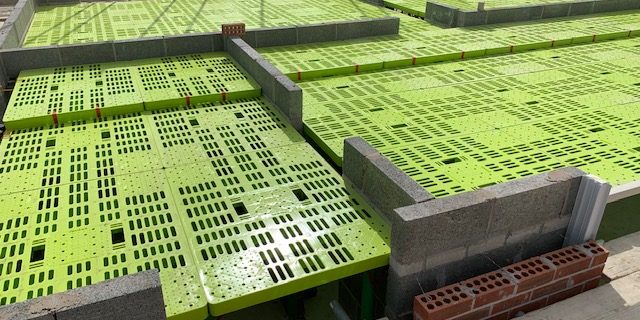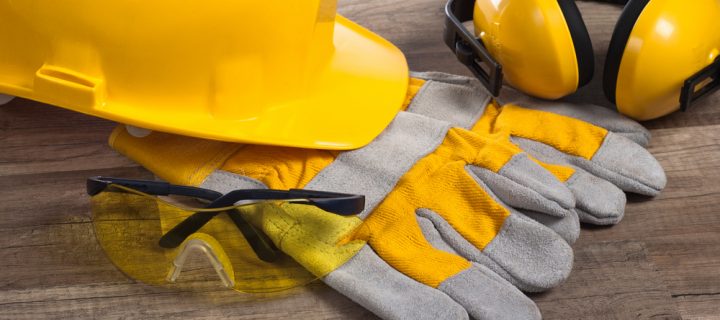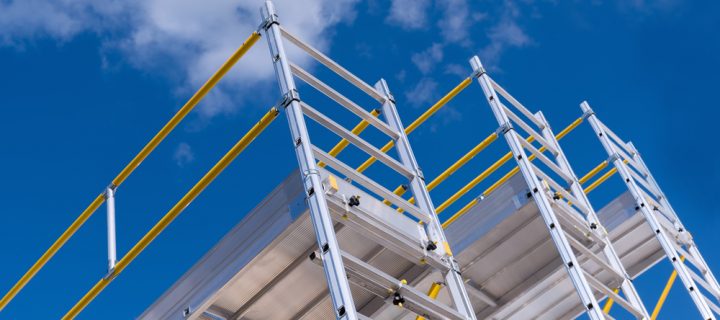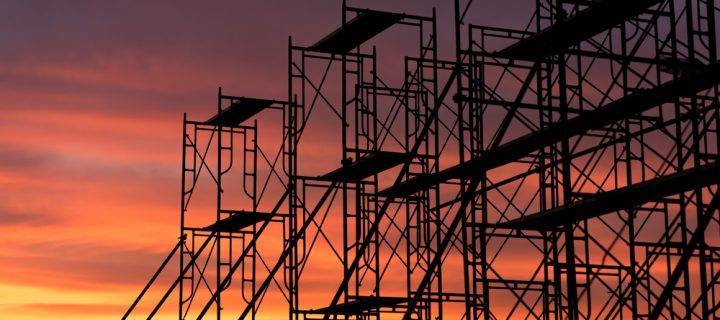Since we started supplying safety decking, Network Scaffold Services have received plenty of enquiries from scaffold contractors look to hire our ‘crash decks’. The term ‘Crash Decking’ is commonly used by construction site professionals when describing fall safety solutions. The term implies there is going to be some kind of impact and it has become associated with the possibility of stopping a falling person or a crash or fall from height. How our safety decking works Network Scaffold‘s safety decks provide an internal fall prevention/work platform for traditional build and construction projects. Please note it is designed to prevent falls, not protect you against them. Our market-leading system is mats designed to mitigate the risk of injury to workers who may fall from heights up to 2.5 metres. Following a rigorous testing regime, our system will also comply with UK Health and Safety regulations. If a worker is on top of our platform they will be safe and secure and cannot fall. Falling from Height When thinking about a worker falling from a height it will be a completely different scenario if they fell onto a deck instead. While your body may experience a tremendous amount of g-force in a short space of time during an accident; this is greatly reduced by crash decking. The system is designed to flex and absorb some of the shock of falling objects and is not designed to protect a person from falling from a height. The more rigid the crash deck, the greater the G-force that would be exerted upon the worker. Get in touch for more information For anyone interested in knowing more about crash decking from Network Scaffold Services, please contact us now. Don’t forget we also provide access scaffolding, plastic hoarding plus alloy towers and edge protection for clients right across Derby and the surrounding...
Read Moreabout Safety Decking ExplainedHere at Network Scaffold we often get asked about planning permission guidelines by potential clients who may require scaffolding. While every project is different there are certain rules you will need to universally comply with. It is always a useful exercise to check with your local authority before committing to any project, as there will be times permitted development will not apply. For example, if you live in a designated area or a listed building or have already altered your home considerably then permitted developments might not comply. Larger build projects, including knocking down and rebuilding or adding a big extension are instances where permission is needed from your local authority. Is Planning Permission Needed for an extension? You will be able to build a single-storey extension without planning permission as long as you stay within the parameters below – The extension does not sit forward of the principal elevation Materials should be similar Where the extension is within 2 metres of any boundary, the eaves cannot be higher than 3 metres and no more than 4 metres in height otherwise Rear extensions need to be no more than 4 metres in depth on a detached house or 3 metres in depth on semi-detached or terrace houses For side extensions, the width of the extension must not be greater than half the width of the original dwelling. Side extensions are not permitted on Article 1(5) Land. Talk to the scaffolding specialists If you have any questions regarding planning permission or scaffolding, please contact Network Scaffold Services now. We have also recently started supplying plastic hoarding and safety decking for customers across Derby and the surrounding areas. Our well-situated depot is also close to major routes such as the A50, A38 and M1. Our wealth of experience in the scaffolding industry means our management team and employees fully understand timescales and customer...
Read Moreabout Knowing When You Need Planning PermissionAn occupational health and safety (OH&S) management system aim to significantly reduce the risk of injury, accidents, and work-related illness in businesses. Having a healthy and physical fit workforce is a mainstay of many company’s success. Here at Network Scaffold Services were proud to be certified for OHSAS 18001, and we will explain how this benefits our business and our clients during this post. OHSAS 18001 explained The OHSAS 18001 Certification Scheme is an occupational health and safety standard designed to enable organisations to control risks and improve occupational health and safety performance. The certification places a proactive and preventative emphasis on risk-control factors by identifying and assessing how likely hazards are in your workplace. As an essential management system, OHSAS 18001 helps you reduce direct and indirect costs while preventing workplace injuries. Conforming to this third-party certification safeguards employees, suppliers and customers from risk. By implementing this comprehensive programme into your business you will also be ensuring health and safety in the workplace. What are the benefits? Save money – You will reduce the direct and indirect costs from accidents, diseases and other factors. Boost productivity – The reduction of downtime caused by sickness or injury to workers will boost productivity. Minimise risk – The risk to human resources across all working environments will be minimised. Gain a competitive edge – Demonstrating the OH&S compliance within your organisation to all stakeholders will showcase your business as a trusted third-party certification partner. Improve transparency – Transparency increases in your company with a clearer understanding of safety processes. Want to know more? Contact Network Scaffold today If you would like to know more about the OHSAS 18001 certification or more about services we offer at Network Scaffold, please get in touch now. We are the leading provider of scaffolding, safety decking and plastic hoarding for customers right across Derby and the surrounding areas such as...
Read Moreabout What is OHSAS 18001 certification?When used correctly, scaffolding can be a helpful way for workers to reach high up areas and perform important tasks. However, when not used correctly it can be very dangerous. It is crucial that all managers and supervisors know how to construct a safe working platform and provide sufficient fall protection. The lack of fall protection and the potential collapse of the scaffold are some of the hazards that can happen because of an unstable structure or overloading of weight. Another risk is the danger of being struck by falling tools, debris and work materials plus when scaffolding is dangerously close to overhead power lines it can result in electrocution. If the scaffold is deemed unsafe on a building site. workers will have the right to refuse to use it. Appropriate health and safety equipment is always needed to perform work on these platforms. Employers have the responsibility to ensure that any work tasks performed are done in the safest way possible. Why scaffolding needs to be inspected Before using a scaffold system, a survey of the work area needs to be performed to check for any potential hazards. This means looking for debris, high tension wires, ditches plus unguarded openings. They will also need to check any damage or alterations and if the system needs to be taken apart or moved it will require another inspection before being used to check nothing has become damaged or defective. You will need to know the system’s load capacity before using it as the platform will need to be strong enough to hold the desired weight or it will be at risk of collapsing. Never try to fit more workers onto a scaffold platform than it can safely handle and do not overload it with equipment or materials. Talk to the experts If you have any questions about scaffold systems from Network Scaffold Services, please get in touch today. Our team of experts will be more than happy to...
Read Moreabout Preventing falls on scaffoldingThere are plenty of misconceptions regarding working at height and the use of scaffolding. Here at Network Scaffold Services, we have years of experience supplying scaffold, alloy towers and access scaffolding to clients all across Derby. This is the reason we have put together this guide, so if it is your first time working with us, you know what to expect. When Do I Need Scaffolding? It is the decision of your trader to assess the level of risk and use the most appropriate equipment. For example, fixing a single broken tile on a low roof isn’t the same as installing solar panels 20 stories up. Traders need to ensure their staff are completely safe when working on a property, which means working from the ground, if possible. If working at height is required, the risk of falling must be minimised by using scaffolding. Do I Need a Scaffold Licence? If your builder or scaffolder needs to erect the scaffold within the boundary of your property there is no need for a licence. However, if any part of the scaffold needs to be placed on pavement or the road outside the property, the builder or scaffolder needs to obtain a licence from your local council. While it is their responsibility to get the licence, you will need to check that they have the appropriate paperwork. If there is a risk to the public you must schedule scaffolding work for quiet times or get a highway closure from your local council. Who is responsible for health and safety? For work completed on your home that is not connected with any business; the builder, scaffolder or contractor supplying the scaffolding is responsible for maintaining safety on the site. The rules are different for individuals, partnerships or companies that have construction work carried out as part of their business practices. Property developers and companies managing domestic properties like landlords, rental agents or estate agents fall under this bracket. The Construction (Design and Management) Regulations 2015 state that their main responsibility is to ensure their project is suitably managed and the health and safety of anyone who may be affected by the construction work, including the general public. Contact Network Scaffold with any...
Read Moreabout What are the rules regarding scaffolding?




